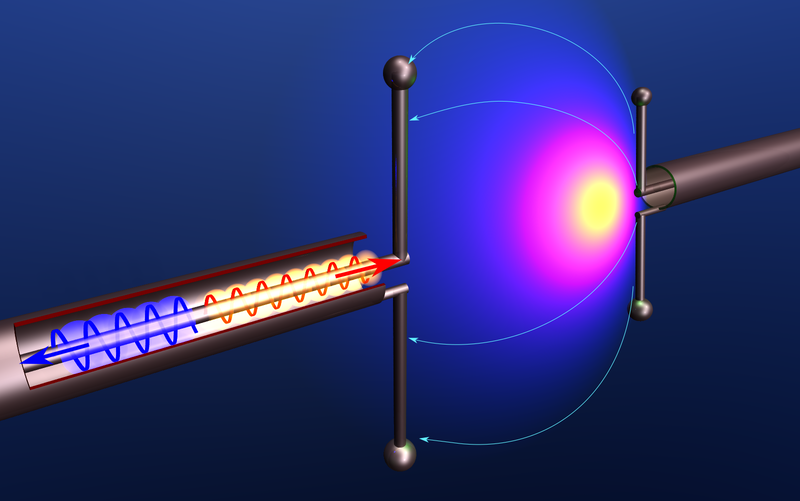Wave Trick May Lead to Wireless Charging at a Distance
You can charge your phone on a “charging mat” if you don’t want to plug it in, and in the future, you may not even have to put it down. However, one major challenge for long-distance wireless charging is the difficulty of consistently transferring a sufficient amount of energy from electromagnetic waves to the battery. Now researchers have demonstrated a new concept that solves this problem and that has advantages over previous solutions. Carefully chosen electromagnetic waves are sent from the battery circuit to interfere with the electromagnetic fields at the receiving antenna in a way that improves the transfer efficiency and could lead to more practical, long-distance wireless charging.
Wireless power transfer over distances longer than a few centimeters will be useful for mobile consumer electronics, electric vehicles, and medical implants. There have been some experimental demonstrations of prototype systems [1], but it’s still difficult to consistently and efficiently transfer power from free-space radio-frequency waves, through an antenna, and into an electronic circuit. The system can be arranged to maximize power to the circuit in one configuration, but as soon as someone walks between the transmitter and the power-receiving device, or the device is moved, the power received can drop dramatically.
The problem is that the antenna doesn’t simply absorb radiation; it also sends some of the impinging radiation back into the surroundings. There is a coupling constant (a number) associated with each of the two processes—radiating to the environment and transmitting to the connected circuit (the load). When these coupling constants are equal, it turns out that the energy transfer to the circuit is maximized. But if the antenna is then moved near an object that reflects radiation, for example, the coupling constant for radiating will change and throw the system out of balance.
To deal with such problems, researchers have added adjustable circuit elements such as capacitors or inductors that can be tuned to bring back the balance. But changing the load “is complicated and inefficient, and it does not necessarily work if things change drastically,” says Andrea Alù of the University of Texas at Austin and the City University of New York.
Alù and colleagues have come up with a new solution. It involves sending a signal from the load to the antenna with a particular phase and amplitude. This “auxiliary” signal can be tuned to enhance wave transmission to the load through wave interference, which effectively compensates for the imbalance in the coupling constants without any need to modify the load. Alù says that the phase and amplitude of the auxiliary signal could be chosen by a feedback loop that retunes itself automatically as changes arise in the environment.
To demonstrate the principle, the team used a signal generator to produce and deliver microwave power through space from a transmitting antenna to a receiving antenna 40 cm away. A coaxial cable connected the antenna to the load. The researchers showed that, even with a large coupling constant mismatch, their scheme could restore maximal power transfer.
“This work points to the potential of applying physics concepts to improve the robustness of wireless power transfer,” says electronic engineer Shanhui Fan of Stanford University in California, who calls the work “innovative.”
However, Morris Kesler, chief technical officer of Witricity, a company aiming to commercialize wireless power transfer, says that the advantages of the approach have yet to be proven. Although he thinks the new work is worth pursuing, “there are other approaches for adjusting the [mismatch] on the device side to achieve better efficiency or increase received power, and I’m not yet convinced that it would be worthwhile trying to implement [this one].” Kesler is particularly concerned that in the experiments, an auxiliary signal power of 100 milliwatts was required to receive 105 milliwatts wirelessly.
But Alù feels that that’s something of a worst-case scenario. “In the case of highly mismatched loads, as in our experiment, it is necessary to transmit a signal carrying power larger than the net received power,” he says. “But this is not the case for small detunings from the matched condition, which may arguably be the most common scenario.” Besides, he says, the auxiliary signal power is not wasted but instead is reflected from the antenna back to the circuit receiving power.
This research is published in Physical Review Letters.
–Philip Ball
Philip Ball is a freelance science writer in London. His latest book is How Life Works (Picador, 2024).
References
- A. Kurs, A. Karalis, R. Moffatt, J. D. Joannopoulos, P. Fisher, and M. Soljacic, “Wireless Power Transfer via Strongly Coupled Magnetic Resonances,” Science 317, 83 (2007).





